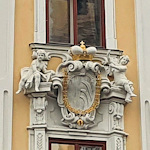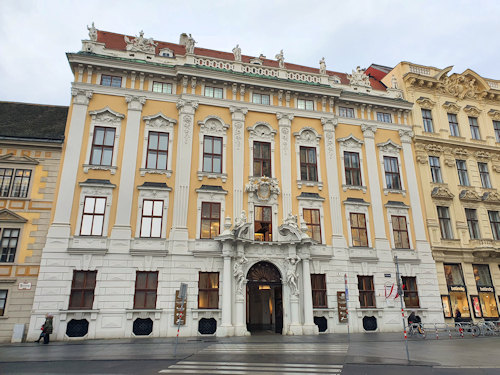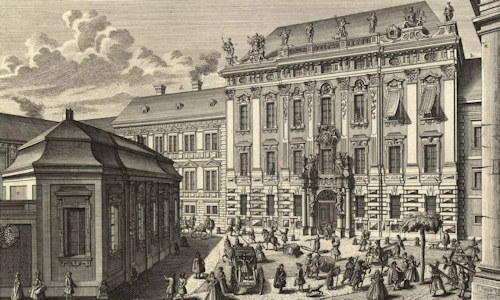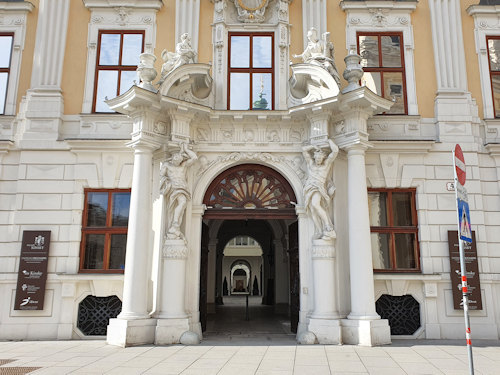
When you’ve climbed the ranks to Field Marshall and spent much of your time cuffing the ears of your Emperor’s enemies, you deserve a decent place to stay near the court. Which is presumably why Count Daun built what is now known as Palais Kinsky.
- Magnificent Baroque palace in perfect condition
- Constructed in the early 18th century
- Look, particularly, at the entrance portal
- Now a prestigious event location
- Find a guided tour* for your Vienna trip
- See also:
The Kinskypalais

(View across from the Freyung)
Just about every address on the Freyung seems to have the word palais at the front. And Number 4 is no different. Palais Kinsky sits off to one side of the square, but that does little to hide its majesty.
This is what we might call a Prachtbau in German: a building of magnificence. Count Wirich Philipp Lorenz Daun, a well-travelled and admirably-named officer and politician in the service of the Habsburgs, built this Baroque palais in the 1710s.
Daun presumably needed a home in tune with his exalted status: he held the title of Viceroy of Naples for a time and also served as governor of the Duchy of Milan.
The architect was Johann Lukas Hildebrandt, the name behind one of Vienna’s most famous landmarks: the Belvedere Palace complex.
The two locations share other connections:
- The Italian painter Carlo Carlone completed ceiling frescoes at both Upper Belvedere palace and Palais Kinsky. Even today, a Belvedere exhibition series bears his name
- Daun actually served under Belvedere’s owner (Prince Eugene of Savoy) during, for example, the pursuit of the Ottomans across Europe following the 1683 siege of Vienna

(The palais pictured in a 1733 book published by Johann Andreas d. Ä. Pfeffel. The drawing was by Salomon Kleiner, engraved by Johann August Corvinus; Wien Museum Inv.-Nr. 105765/97; excerpt reproduced with permission under the terms of the CC0 licence)
Not long after Daun’s death, the family sold the palais, which eventually came into the ownership of Countess Rosa Kinsky toward the end of the 18th century.
And thus we have the origins of the palais names, since you’ll find the building referred to as both Palais Kinsky or Palais Daun-Kinsky.
Rosa Kinsky (1758 – 1814) led a colourful existence. As salon host, she entertained the cream of Viennese society all the way up to Emperor Joseph II, but artists, intellectuals and other public figures often enjoyed her hospitality, too.
Today’s palais is in pristine condition and serves, for example, as an (extremely) prestigious venue.
(Ernst Graner, The Portal of Palais Kinsky, around 1901/1902, watercolour on paper, 52.5 x 39.5 cm, Belvedere, Wien, Inv.-Nr. 506 © Belvedere, Wien. Reproduced with permission under the terms of Creative Commons License CC BY-SA 4.0.)
The building’s front entrance enjoys particular acclaim, and found itself immortalised in a watercolour by the artist Ernst Graner (1865-1943), who painted many streets, scenes and buildings in Vienna.
Here’s how the portal looks now, showing how very little has changed from Graner’s time:

(The entrance in 2022)
How to get to Palais Kinsky
Follow the tips for reaching the Freyung (see the end of that article).
As mentioned earlier, many of the neighbours bear the palais designation. Like Palais Porcia, for example, home to the IT department of the Austrian Federal Chancellery last time I checked.
Further up Herrengasse you’ll find Palais Trauttmansdorff, Palais Orsini-Rosenberg, and Palais Ferstel. Pop over the road to find Palais Harrach and Palais Hardegg.
You’d think half of Vienna lives in a palais (spoiler: we don’t. At least, I certainly don’t).
Address: Freyung 4, 1010 Vienna
